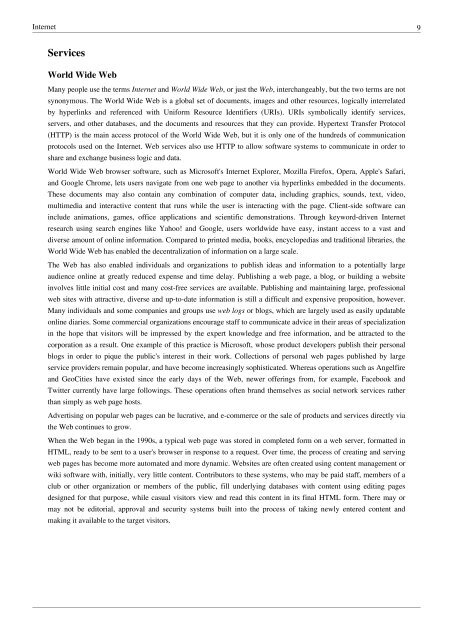Internet Protocol - Research by Kirils Solovjovs
Internet Protocol - Research by Kirils Solovjovs
Internet Protocol - Research by Kirils Solovjovs
You also want an ePaper? Increase the reach of your titles
YUMPU automatically turns print PDFs into web optimized ePapers that Google loves.
<strong>Internet</strong> 9<br />
Services<br />
World Wide Web<br />
Many people use the terms <strong>Internet</strong> and World Wide Web, or just the Web, interchangeably, but the two terms are not<br />
synonymous. The World Wide Web is a global set of documents, images and other resources, logically interrelated<br />
<strong>by</strong> hyperlinks and referenced with Uniform Resource Identifiers (URIs). URIs symbolically identify services,<br />
servers, and other databases, and the documents and resources that they can provide. Hypertext Transfer <strong>Protocol</strong><br />
(HTTP) is the main access protocol of the World Wide Web, but it is only one of the hundreds of communication<br />
protocols used on the <strong>Internet</strong>. Web services also use HTTP to allow software systems to communicate in order to<br />
share and exchange business logic and data.<br />
World Wide Web browser software, such as Microsoft's <strong>Internet</strong> Explorer, Mozilla Firefox, Opera, Apple's Safari,<br />
and Google Chrome, lets users navigate from one web page to another via hyperlinks embedded in the documents.<br />
These documents may also contain any combination of computer data, including graphics, sounds, text, video,<br />
multimedia and interactive content that runs while the user is interacting with the page. Client-side software can<br />
include animations, games, office applications and scientific demonstrations. Through keyword-driven <strong>Internet</strong><br />
research using search engines like Yahoo! and Google, users worldwide have easy, instant access to a vast and<br />
diverse amount of online information. Compared to printed media, books, encyclopedias and traditional libraries, the<br />
World Wide Web has enabled the decentralization of information on a large scale.<br />
The Web has also enabled individuals and organizations to publish ideas and information to a potentially large<br />
audience online at greatly reduced expense and time delay. Publishing a web page, a blog, or building a website<br />
involves little initial cost and many cost-free services are available. Publishing and maintaining large, professional<br />
web sites with attractive, diverse and up-to-date information is still a difficult and expensive proposition, however.<br />
Many individuals and some companies and groups use web logs or blogs, which are largely used as easily updatable<br />
online diaries. Some commercial organizations encourage staff to communicate advice in their areas of specialization<br />
in the hope that visitors will be impressed <strong>by</strong> the expert knowledge and free information, and be attracted to the<br />
corporation as a result. One example of this practice is Microsoft, whose product developers publish their personal<br />
blogs in order to pique the public's interest in their work. Collections of personal web pages published <strong>by</strong> large<br />
service providers remain popular, and have become increasingly sophisticated. Whereas operations such as Angelfire<br />
and GeoCities have existed since the early days of the Web, newer offerings from, for example, Facebook and<br />
Twitter currently have large followings. These operations often brand themselves as social network services rather<br />
than simply as web page hosts.<br />
Advertising on popular web pages can be lucrative, and e-commerce or the sale of products and services directly via<br />
the Web continues to grow.<br />
When the Web began in the 1990s, a typical web page was stored in completed form on a web server, formatted in<br />
HTML, ready to be sent to a user's browser in response to a request. Over time, the process of creating and serving<br />
web pages has become more automated and more dynamic. Websites are often created using content management or<br />
wiki software with, initially, very little content. Contributors to these systems, who may be paid staff, members of a<br />
club or other organization or members of the public, fill underlying databases with content using editing pages<br />
designed for that purpose, while casual visitors view and read this content in its final HTML form. There may or<br />
may not be editorial, approval and security systems built into the process of taking newly entered content and<br />
making it available to the target visitors.


